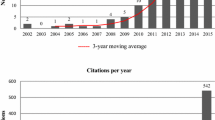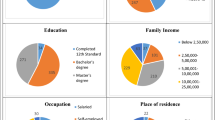Abstract
We estimate a two-stage Heckman selection model of credit card adoption and use with a unique dataset that combines administrative data from the Equifax credit bureau and self-reported data from a representative survey of consumers. Higher-income consumers carry higher credit card balances, but they tend to repay those balances each month. Credit card revolvers have lower income and are less educated. Revolvers are twice as likely to use debit cards as credit cards for payments, but they carry much higher balances on their credit cards. The high cost of paying off credit card debt likely exacerbates existing inequalities in disposable income. Unlike the mortgage market, we find no evidence for lenders’ cutoff between subprime and prime consumers in the credit card market.





Similar content being viewed by others
Notes
The SCPC questionnaire and data are available at https://www.frbatlanta.org/banking-and-payments/consumer-payments/survey-of-consumer-payment-choice.
The two-stage Heckman model cannot be estimated here, because the entire sample consists of credit card holders. Thus, credit card adoption = 1 for everyone in the sample, and so stage 1 of Heckman (adoption) cannot be identified.
Federal Reserve Economic Data, see https://fred.stlouisfed.org/series/TERMCBCCINTNS
RD analysis includes several steps. In step 1, we plot the relationship between the outcome variable and the rating variable to investigate what functional form to use. The data fit a 2nd degree polynomial with no discontinuity at 650. In step 2, we select a bandwidth based on minimizing MSE and test the validity of RD. The bandwidth is 60, or consumers with risk score between 590 and 710. RD is tested by examining if consumers can cross the 650 threshold and if the density of the variable is continuous. The test showed no statistical evidence of systematic manipulation of the score variable. In step 3, we estimate the treatment effect using observations within the chosen bandwidth [590, 710] using the specification: Credit _ Balance = α + β0Ti + β1Ri + β2RiTi + β3DEMi + εi where Ti is the treatment effect indicator, and Ri is the rating variable included to correct for selection bias (Heckman and Robb 1985). The coefficient on the treatment effect indicator Ti is not significant.
References
Agarwal S, Ambrose BW, Liu C (2006) Credit lines and credit utilization. J Money Credit Bank 38(1):1–22
Angrisani, Marco, Kevin Foster, and Marcin Hitczenko (2017) The 2015 survey of consumer payment choice: technical appendix. Federal Reserve Bank of Boston Research Data Reports No 17–4
Bhardwaj, Geetesh, and Rajdeep Sengupta (2011) Credit scoring and loan default. Federal Reserve Bank of St. Louis Working Paper No. 2011-040A
Brevoort KP (2011) Credit card redlining revisited. Rev Econ Stat 93(2):714–724
Brown, Meta, Sarah Stein, and Basit Zafar (2013) The impact of housing markets on consumer debt: credit report evidence from 1999 to 2012. Federal Reserve Bank of New York Staff Reports No 617
Brown M, Haughwout A, Lee D, van der Klaauw W (2015) Do we know what we owe? Consumer debt as reported by borrowers and lenders. Econ Policy Rev 21(1):19–44
Calem PS, Jagtiani J, Lang WW (2017) Foreclosure delay and consumer credit performance. J Financ Serv Res 52(3):225–251
Castronova E, Hagstrom P (2004) The demand for credit cards: evidence from the survey of consumer finances. Econ Inq 42(2):304–318
Ching A, Hayashi F (2010) Payment card rewards programs and consumer payment choice. J Bank Financ 34(8):1773–1787
Cole, Allison, Scott Schuh, and Joanna Stavins (Forthcoming) Matching consumer survey data with credit Bureau Data. Federal Reserve Bank of Boston Research Department Working Papers.
Connolly, Sean, and Joanna Stavins (2015) Payment instrument adoption and use in the United States, 2009–2013, by consumers’ demographic characteristics. Federal Reserve Bank of Boston Research Data Reports No. 15–6
Deaton A, Grosh M (2000) Consumption. In: Grosh M, Glewwe P (eds) Chapter 17Designing household survey questionnaires for developing countries: lessons from ten years of LSMS experience. World Bank, Washington, DC
Demyanyk, Yuliya, and Matthew Koepke (2012) “Americans cut their debt.” Federal Reserve Bank of Cleveland Economic Commentary August 2012
Dey, Shubhasis, and Gene Elwood Mumy (2009) Determinants of borrowing limits on credit cards. Available at SSRN: https://ssrn.com/abstract=889719 or https://doi.org/10.2139/ssrn.889719
Emekter R, Yanbin T, Jirasakuldech B, Min L (2015) Evaluating credit risk and loan performance in online peer-to-peer (P2P) lending. Appl Econ 47(1):54–70
Fulford, Scott, and Scott Schuh (2017) Credit card utilization and consumption over the life cycle and business cycle. Federal Reserve Bank of Boston Research Department Working Papers No. 17–14
Greene, Claire, Scott Schuh, and Joanna Stavins (2017) The 2015 survey of consumer payment choice: summary results. Federal Reserve Bank of Boston Research Data Reports No. 17–3
Gross DB, Souleles NS (2002) An empirical analysis of personal bankruptcy and delinquency. Rev Financ Stud 15(1):319–347
Han, Song, Benjamin J. Keys, and Geng Li (2015) Information, contract design, and unsecured credit supply: evidence from credit card mailings, Finance and Economics Discussion Series 2015–103, Board of Governors of the Federal Reserve System
Heckman JJ (1976) The common structure of statistical models of truncation, sample selection and limited dependent variables and a simple estimator for such models. The Annals of Economic and Social Measurement 5(4):475–492
Heckman J and Robb R Jr. (1985) Alternative methods for evaluating the impact of interventions. J Econometrics 30(1-2):239–267
Hurd MD, Rohwedder S (2009) Methodological innovations in collecting spending data: the HRS consumption and activities mail survey. Fisc Stud 30:435–459
Imbens G, Lemieux T (2008) Regression discontinuity designs: a guide to practice. J Econ 142:615–635
Karlan D, Zinman J (2008) Lying about borrowing. J Eur Econ Assoc 6(2–3):510–521
Keys BJ, Mukherjee T, Seru A, Vig V (2010) Did securitization Lead to lax screening? Evidence from subprime loans. Q J Econ 125(1):307–362
Klee, Elizabeth (2006) Families’ use of payment instruments during a decade of change in the U.S. payment system. Board of Governors of the Federal Reserve System Finance and Economics Discussion Series 2006–01
Koulayev S, Rysman M, Schuh S, Stavins J (2016) Explaining adoption and use of payment instruments by U.S. consumers. RAND J Econ 47(2):293–325
Lopes P (2008) Credit card debt and default over the life cycle. J Money Credit Bank 40(4):769–790
Meier S, Sprenger C (2010) Present-biased preferences and credit card borrowing. Am Econ J Appl Econ 2(1):193–210
Mester LJ (2012) Changes in the use of electronic means of payment: 1995–2010. Federal Reserve Bank of Philadelphia Business Review Q3:25–36
Min I, Kim J-H (2003) Modeling credit card borrowing: a comparison of type I and type II Tobit approaches. South Econ J 70(1):128–143
Muñoz, Ana Patricia, and Kristin F. Butcher (2013) Using credit reporting agency data to assess the link between the community reinvestment act and consumer credit outcomes. Federal Reserve Bank of Boston Community Development Discussion Papers No. 2013–2
Musto DK, Souleles NS (2006) A portfolio view of consumer credit. J Monet Econ 53(1):59–84
Nichols J, Pennington-Cross A, Yezer A (2005) Borrower self-selection, underwriting costs, and subprime mortgage credit supply. J Real Estate Financ Econ 30(2):197–219
Rysman M (2007) An empirical analysis of payment card usage. J Ind Econ 55(1):1–36
Sánchez, Juan M. (2014) Paying down credit card debt: a breakdown by income and age. Federal Reserve Bank of St. Louis Regional Economist April
Schuh S, Stavins J (2010) Why are (some) consumers (finally) writing fewer checks? The role of payment characteristics. J Bank Financ 34(8):1745–1758
Schuh S, Stavins J (2013) How consumers pay: adoption and use of payments. Accounting and Finance Research 2(2)
Stavins, Joanna (2016) The effect of demographics on payment behavior: panel data with sample selection. Federal Reserve Bank of Boston Research Department Working Papers No. 16–5
Stavins, Joanna (2017) How do consumers make their payment choices? Federal Reserve Bank of Boston Research Data Reports No. 17–1
Sudman S, Bradburn NM, Schwarz N (1996) Thinking about answers: the application of cognitive processes to survey methodology. Jossey-Bass, San Francisco
Tourangeau R, Rasinski KA, Bradburn N (1991) Measuring happiness in surveys: a test of the subtraction hypothesis. Public Opin Q 55(2):255–266
Zinman J (2009) Where is the missing credit card debt? Clues and implications. Rev Income Wealth 55(2):249–265
Acknowledgements
The author thanks José Fillat, Joe Peek, and an anonymous referee for helpful comments, and Allison Cole and Liang Zhang for excellent research assistance. The views expressed here are those of the author and do not necessarily represent the views of the Federal Reserve Bank of Boston, the Board of Governors, or the Federal Reserve System.
Author information
Authors and Affiliations
Corresponding author
Additional information
Publisher’s Note
Springer Nature remains neutral with regard to jurisdictional claims in published maps and institutional affiliations.
Rights and permissions
About this article
Cite this article
Stavins, J. Credit Card Debt and Consumer Payment Choice: What Can We Learn from Credit Bureau Data?. J Financ Serv Res 58, 59–90 (2020). https://doi.org/10.1007/s10693-019-00330-8
Received:
Revised:
Accepted:
Published:
Issue Date:
DOI: https://doi.org/10.1007/s10693-019-00330-8




